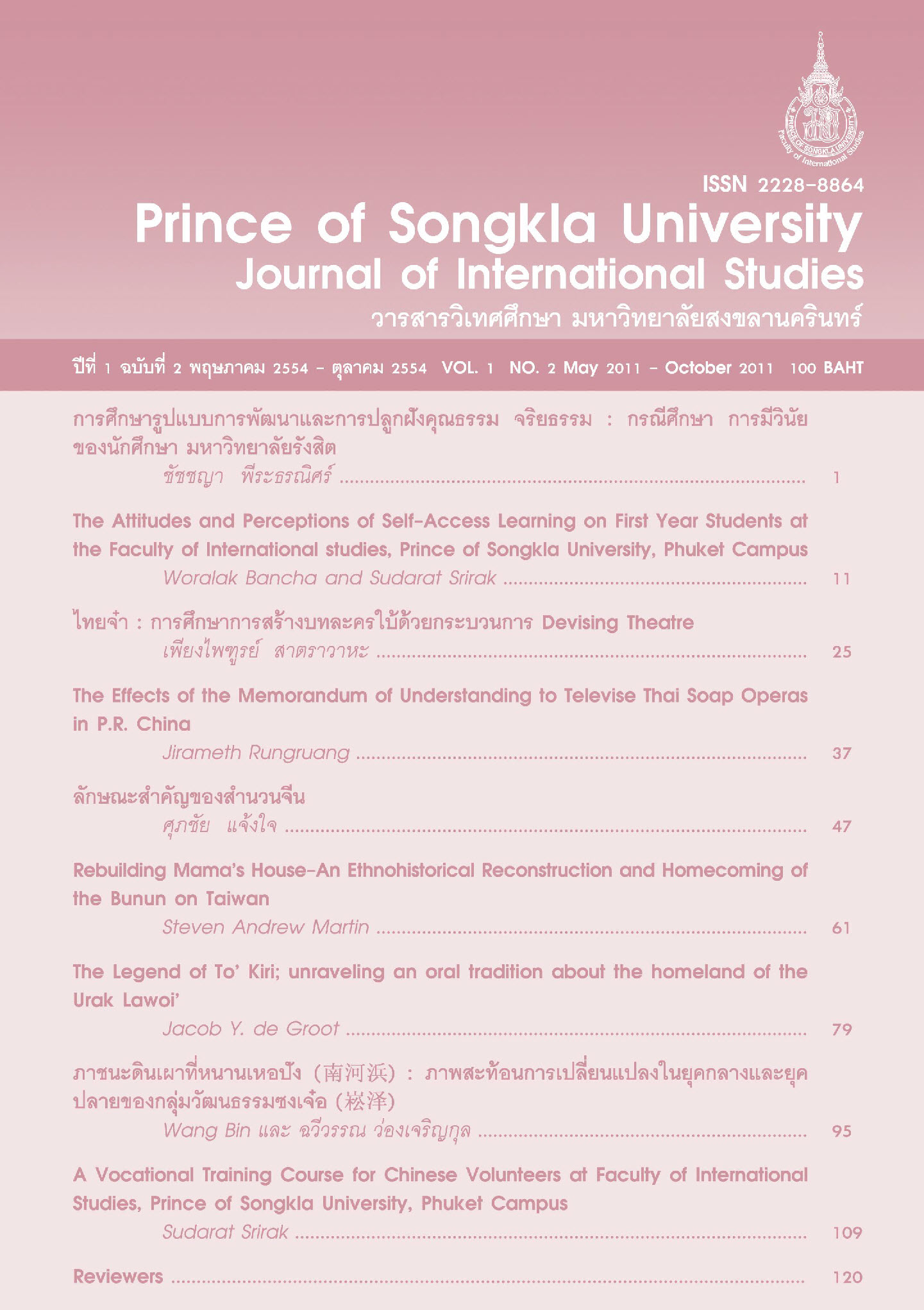The Legend of To' Kiri; unraveling an oral tradition about the homeland of the Urak Lawoi'
Main Article Content
Abstract
The Urak Lawoi are a Malay ethnic group nowadays living primarily in permanent settlements on the islands of Phuket, Phi Phi, Jum (also called Pu), Lanta, Bulon, Lipe and Adang along the Andaman coast of Thailand. Originally, they were a nomadic sea people, living mainly on their boats and in temporary settlements along the islands coasts. From around 1910 the Urak Lawoi appeared rather suddenly on the islands along the Thai coast, where they sought a living for several decades. Their business was fishing and gathering other fruits of the sea, such as crustaceans or tripang. To They would repair to temporary shelters on the islands when their catch had to be cured for trade, or when weather conditions made it impossible to stay on open sea. Depending on the seasons and the connected availability of sea products they would either stay on coastal islands like Lanta, Talibong or Tarutao, or venture further out and camp on the outlying islands of Adang, Lipe, Rawi, Rok Nai or Phi Phi. Beginning in the 1940ies the Urak Lawoi settled on the islands which had formerly been merely their provisional domiciles, and they became permanent, though not yet fully legal, citizens of Thailand. The Urak Lawoi people have no literary tradition. Literacy among the Urak Lawoi dates from the time of their settlement, when their children started to follow curricula at Thai schools. Texts in Urak Lawoi are strictly modern, and written in a modified Thai script. Due to this fact it is impossible to know from written sources where the homeland of the Urak Lawoi lay. A story widely told among the Urak Lawoi gives us a glimpse of the possible whereabouts of the land of their ancestors. According to this oral tradition, the founder of the Urak Lawoi clan arrived in Thailand four to five generations ago, from the Indonesian Daerah Istimewah2 Aceh, or, as it was then called, the province of Atjeh in the Netherlands Indies. This paper aims to determine the true homeland of the Urak Lawoi people by unraveling the oral tradition concerning their origin through linking available historical and linguistic evidence
Article Details
Statements and opinions expressed in articles herein are those of the authors and do not necessarily reflect the position of the editors or publisher.
Article, information, text, image, etc. which are published in Journal of International Studies, belong to Journal of International Studies. If anybody or any organization would like to use part or whole of them, they must receive written permission from Journal of International Studies before usage.
References
Pengembangan Bahasa, Departemen Pendidikan Nasional.
Groot, J. Y. de. (Unpublished). A Grammar of Urak Lawoi'. Phuket: Prince of Songkla
University
Groot, J. Y. de. (2010). Urak Lawoi'; a language in transition. In Third 31° annual PSU
Phuket Research Conference, 2010. Phuket: Prince of Songkla University.
Hogan, D. W. (1974). Men of the Sea: Coastal tribes of South Thailand's West Coast.
Journal of the Siam Society, 2, 11-56.
Lenhart, L. (1997). Orang Suku Laut ethnicity and acculturation. Bijdragen tot de Taal
Land-en Volkenkunde, Riau in Transition, 153 (4). 577-604.
Sugono, D. et al. (2008). Kamus Bahasa Indonesia. Jakarta: Pusat Pembinaan dan
Pengembangan Bahasa, Departemen Pendidikan Nasional.
(n.a.). (n.y.). หลักสูตรความรู้ท้องถิ่นของชาวอูรักลาโว๊ยหมู่เกาะอาดัง-ราวี. สตูล: โรงเรียนบ้านเกาะอาดัง.
อมร ทวีสักดิ์. (2529). ภาษาชาวเล. กรุงเทพฯ: มหาวิทยาลัยมหิดล.


